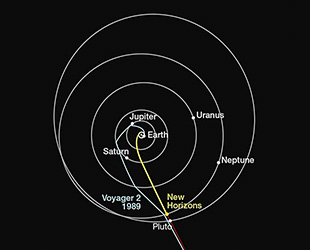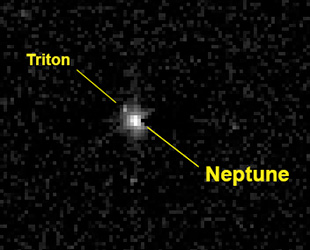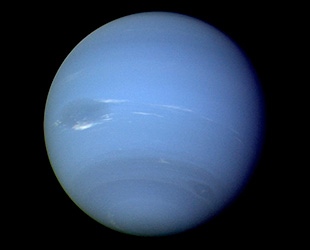August 25, 2014 — An interplanetary crossing on Monday (Aug. 25) evoked a crossover in space history, as NASA's New Horizons spacecraft traversed the orbit of Neptune on its way to Pluto and beyond, 25 years to the day after the Voyager 2 probe became the first to encounter the eighth planet from the sun.
Voyager 2's flyby of Neptune a quarter of a century ago marked the final destination on its "grand tour" of the outer planets, whereas Monday's milestone for New Horizons is only the start of its approach to its first and primary target. New Horizons will come closest to the dwarf planet Pluto on July 14, 2015.
"It's a cosmic coincidence that connects one of NASA's iconic past ... explorers with our next outer solar system explorer," said Jim Green, director of planetary science at NASA Headquarters. "Exactly 25 years ago at Neptune, Voyager 2 delivered our 'first' look at an unexplored planet. Now it will be New Horizons' turn to reveal the unexplored Pluto and its moons in stunning detail next summer on its way into the vast outer reaches of the solar system."
Though New Horizons followed a similar path as Voyager 2, due to the movement of the planets, Neptune was now out of alignment with the piano-sized craft.

Graphic showing the position of the planets on August 25, 2014 with Voyager 2 and New Horizons' trajectories overlayed. (NASA) |
"Neptune has now moved quite a ways from where it was when Voyager 2 encountered it 25 years ago today," Alan Stern, New Horizons' principal investigator, said Monday at a NASA press briefing about the two missions. "In fact, as we cross Neptune's orbit, we are 2.5 billion miles away, 4 billion kilometers."
New Horizons was set to cross the blue gas planet's orbit at 10:04 p.m. EDT Monday (0304 GMT Tuesday).
Mission managers marked the concurrent milestones by releasing an image of Neptune and its moon Triton taken by the New Horizons probe earlier this summer.
"Our image of Neptune with Triton beside it is hauntingly beautiful, even though both objects are just points of light, far, far away," the New Horizons team wrote.

NASA's Pluto-bound New Horizons spacecraft captured this view of the giant planet Neptune and its large moon Triton on July 10, 2014, from a distance of about 2.45 billion miles. (NASA/JHUAPL) |
At its closest approach, the Voyager 2 probe came within 3,000 miles (4,950 kilometers) of the planet's north pole, resolving details that couldn't be seen from Earth, or from New Horizons' current vantage point.
Voyager's visit to the Neptune revealed previously unseen features, such as the "Great Dark Spot," a massive storm similar to, but not as long-lasting, as Jupiter's "Great Red Spot." Voyager also captured clear images of the planet's ring system, which is too faint to be clearly resolved from Earth.
"There were surprises at Neptune and surprises at Triton," Ed Stone, Voyager's project scientist from the California Institute of Technology (Caltech) in Pasadena, Calif., said. "I'm sure that will continue at Pluto."
Many researchers feel that Voyager's 1989 Neptune flyby might have offered a preview of what's to come with New Horizons next summer. Scientists have suggested Triton, with its icy surface, bright poles, varied terrain, and cryo-volcanoes, is a Pluto-like object that Neptune pulled into orbit.
"There is a lot of speculation over whether Pluto will look like Triton, and how well they'll match up," Ralph McNutt of the Applied Physics Laboratory, who served on both the Voyager and New Horizons science teams, said. "That's the great thing about first-time encounters like this — we do not know exactly what we will see, but we know from decades of experience in first-time exploration of planets that we will be very surprised."

Voyager 2 photo of Neptune taken in August 1989. (NASA/JPL) |
It took 12 years for Voyager to reach Neptune. The New Horizons spacecraft, launched on Jan. 19, 2006, covered the same distance in less than nine years. The probe had the highest launch velocity on its departure from Earth and was the first spacecraft to be launched into a direct solar escape trajectory.
Voyager 2, which lifted off on Aug. 20, 1977, also made close flybys of Jupiter, Saturn and Uranus. It is now at a distance of more than 100 times the distance between the Earth and the sun, heading out of the solar system.
New Horizons flew by Jupiter in February 2007 and then crossed the orbits of Saturn and Uranus in June 2008 and March 2011, respectively. After it passes by Pluto and its moons, it will continue to fly outwards, with pending plans to encounter one or two Kuiper Belt icy bodies of about 25 to 55 miles in diameter (40 to 90 kilometers).
"[This] is the first time in a generation — since our heroes on Voyager took us to a new planet for a first time raw reconnaissance — where we will go from a single piece of paper in our knowledge to writing the text book," remarked Stern.
